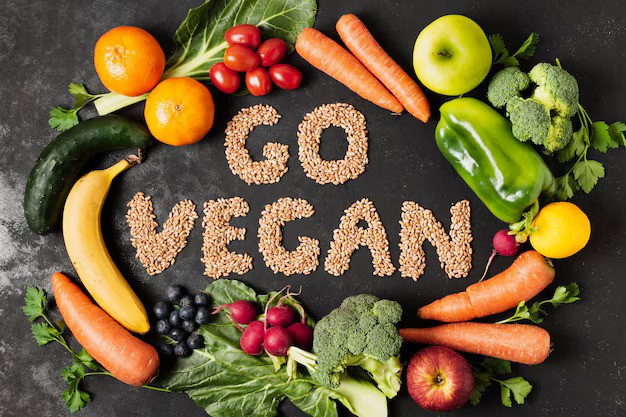Introduction
If you’re looking to lose 10 pounds in a month and want to do it in a healthy, plant-based way, the Vegan diet might be your perfect choice. Going vegan not only benefits the environment and animal welfare, but it’s also highly effective for weight loss. By focusing on nutrient-dense, fiber-rich foods, you can create a calorie deficit that promotes steady, sustainable weight loss. Here are some practical weight loss tips to help you make the most of a vegan diet and reach your goal in 30 days.
1. Prioritize Whole Foods Over Processed Options
Whole foods like vegetables, fruits, whole grains, nuts, and seeds are naturally lower in calories and higher in fiber, which keeps you full longer. Processed vegan foods, even if they’re labeled as “healthy,” often contain added sugars, unhealthy fats, and excess calories that can hinder your weight loss.
Tip: Fill your plate with fresh vegetables, whole grains, and lean plant-based proteins. The closer a food is to its natural state, the more likely it is to support your weight loss goals.
2. Focus on High-Fiber Foods to Keep You Full
Fiber is a game-changer for anyone trying to lose weight. It aids digestion, keeps you feeling full, and helps prevent overeating. High-fiber foods are naturally filling, which is important when trying to create a calorie deficit to lose 10 pounds in a month.
Best choices: Leafy greens, berries, beans, lentils, and whole grains like oats and quinoa. These foods add volume to your meals without adding too many calories, helping you feel satisfied longer.
3. Include Plant-Based Proteins in Every Meal
Protein is essential for muscle maintenance and metabolism, especially when you’re trying to lose weight. Plant-based proteins keep you full and support muscle recovery after workouts. Make sure you’re getting enough protein from a variety of sources to stay energized and curb hunger.
Top picks: Tofu, tempeh, chickpeas, lentils, and quinoa. These options are versatile and can be incorporated into many vegan meals to keep your protein intake high without adding too many calories.
4. Watch Your Portion Sizes
Portion control is key to creating a calorie deficit, even with healthy foods. It’s easy to overeat foods like nuts, seeds, and grains, which are calorie-dense. Being mindful of portion sizes helps you stay within your calorie goals and ensures that you’re consuming just what you need to support your weight loss.
Tip: Use smaller plates and pre-portion snacks like nuts or seeds. Measure out your servings of calorie-dense foods to avoid consuming excess calories unintentionally.
5. Avoid Sugary Beverages and Opt for Water
Sugary drinks, even if they’re plant-based, can add up quickly in calories and sugars, which can sabotage your weight loss progress. Water is the best choice for hydration, and staying hydrated can help reduce hunger, support digestion, and keep your metabolism active.
Quick tip: Aim for at least eight glasses of water a day. You can also add a slice of lemon or cucumber for flavor or sip on herbal teas for variety.

6. Incorporate Healthy Fats, But in Moderation
Healthy fats are crucial for a balanced vegan diet, but they’re calorie-dense, so it’s important to consume them in moderation. Including sources like avocado, nuts, seeds, and olive oil can help you feel satisfied and reduce cravings, but keep portions small to avoid going over your calorie limit.
Best choices: Avocado, almonds, chia seeds, and flaxseeds. These fats add flavor and nutrition to your meals while helping you stay full.
7. Plan Balanced, Nutrient-Dense Meals
Meal planning is a powerful tool for weight loss. It helps you stay on track, avoid last-minute unhealthy choices, and ensures you’re eating a balanced diet. A well-planned vegan meal should include protein, healthy fats, fiber-rich carbohydrates, and lots of vegetables.
Example meal: A bowl with quinoa, roasted vegetables, chickpeas, and a drizzle of tahini dressing. This type of balanced meal provides a variety of nutrients, keeping you full and energized while supporting your weight loss goals.
8. Snack Smartly with Low-Calorie Options
Snacking can be part of a healthy diet, but choosing the right snacks is important when you’re trying to lose 10 pounds in a month. Opt for low-calorie, high-fiber snacks that curb hunger without adding too many extra calories.
Smart snacks: Carrot sticks with hummus, a handful of berries, apple slices with almond butter, or a few nuts. These snacks are nutrient-dense, satisfying, and won’t interfere with your calorie deficit.
9. Exercise Regularly to Boost Weight Loss
While diet is essential for weight loss, combining it with regular exercise can enhance your results. Cardio exercises burn calories, while strength training helps build lean muscle, which boosts metabolism. Aim to incorporate both types of exercise into your routine to maximize fat burning.
Suggested activities: Brisk walking, jogging, cycling, or bodyweight exercises. Even a 30-minute workout daily can make a big difference in your weight loss progress.
10. Track Your Food Intake and Progress
Keeping a food diary or using a tracking app can help you stay accountable and see where you might need adjustments. Tracking your food intake allows you to monitor your calorie consumption and ensure you’re hitting your goals. It also keeps you motivated as you see your progress over time.
Tools to use: Apps like MyFitnessPal or Cronometer can make tracking easier and give you insights into your nutrient intake. Seeing your progress can help you stay motivated and focused on your goal to lose 10 pounds in a month.
Conclusion
Losing weight on a vegan diet is both achievable and sustainable. By focusing on whole foods, high-fiber choices, plant-based proteins, and balanced portions, you can create a healthy, calorie-conscious eating plan that helps you reach your goal of losing 10 pounds in a month. Pair these weight loss tips with regular exercise, mindful hydration, and consistent tracking to stay on track. Start making these adjustments today, and enjoy the benefits of a leaner, healthier body as you move closer to your goals.




